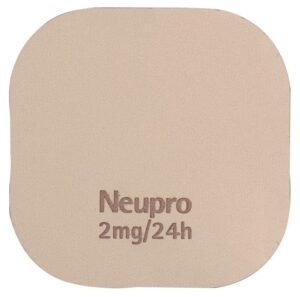7/19/24 – Rotigotine
A few words about my new therapy, a transdermal patch marketed under the name Neupro.
Nepro is designed to deliver a dopamine agonist, rotigotine, through the skin. The keyword here is “agonist”, what does it mean, and how is this particular agonist meant to relieve Parkinson symptoms?
Addressing the first question first, an agonist is a small molecule that impersonates the action of another substance that has a physiological function. In this case, the small molecule being imitated is dopamine, a neurotransmitter that is deficient in Parkinson’s patients. Recall, the gold standard in Parkinson treatment is to relieve this lack of dopamine with carbidopa/levodopa. The levodopa in this combination is converted into dopamine when it gets transported across the blood brain barrier and into the brain. Once it reaches its destination, the newly formed dopamine substitutes for the missing dopamine lacking in Parkinson’s patients.
Dopamine has many functions, but all of them rely on its binding to a receptor. This is getting complicated. What’s a receptor?
Many receptors sit on the surface of cells and communicate signals to the interior. Receptors are proteins that bind small molecules like hormones and neurotransmitters. There are thousands of different receptors throughout our bodies and each one specifically binds a particular small molecule. Each receptor has a site on its surface with a three dimensional shape that is complementary to the small molecule being bound. The small molecule falls into this site and causes the receptor protein to change the shape. In turn this change of shape is communicated to the interior of the cell, causing some actions occur.
There are several dopamine receptors and the complementary dopamine-binding sites that these receptors share also respond to an agonist like rotigotine, thereby eliciting the same response. Thus rotigotine produces the same effect as dopamine. Then why use it instead of dopamine?
I posed this question to Perplexity, my favorite AI assistant. Here are several reasons it came up with:
Better absorption and delivery: Rotigotine is administered through a transdermal patch, which allows for steady delivery of the medication over 24 hours. This provides more consistent blood levels compared to oral medications or direct dopamine administration.
Blood-brain barrier penetration: Unlike dopamine, rotigotine can cross the blood-brain barrier, allowing it to directly act on dopamine receptors in the brain.
Longer half-life: Rotigotine has a longer duration of action compared to dopamine, which is rapidly metabolized in the body.
Convenience: The transdermal patch formulation of rotigotine offers a once-daily application, which can improve medication adherence for patients.
Bypassing gastrointestinal issues: The transdermal delivery system avoids potential absorption issues related to gastrointestinal problems, which can be common in Parkinson’s disease patients.
I’ve been on the patch for only three days. I’ll let you know how it goes in the future.